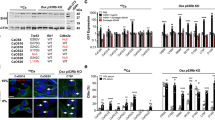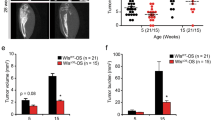Abstract
Synthesis of cell attachment proteins and cytokines, such as osteopontin (OPN), can promote tumor cell remodeling of the extracellular matrix into an environment that promotes tumor cell attachment and migration. We investigated the transcriptional regulation of OPN in the U-251MG and U-87MG human malignant astrocytoma cell lines. Deletion and mutagenesis analyses of the OPN promoter region identified a proximal promoter element (−24 to −94 relative to the transcription initiation site) that is essential for maintaining high levels of OPN expression in the tumor cells. This element, designated RE-1, consists of two cis-acting elements, RE-1a (−55 to −86) and RE-1b (−22 to −45), which act synergistically to regulate the activity of the OPN promoter. Gel shift assays using nuclear extracts of U-251MG cells demonstrated that RE-1a contains binding sites for transcription factors Sp1, the glucocorticoid receptor, and the E-box-binding factors, whereas RE-1b contains a binding site for the octamer motif-binding protein (OCT-1/OCT-2). Inclusion of antibodies directed toward Myc and OCT-1 in the gel shift assays indicated that Myc and OCT-1 participate in forming DNA-protein complexes on the RE-1a and RE-1b elements, respectively. Our results identify two previously unrecognized elements in the OPN promoter that act synergistically to promote upregulation of OPN synthesis by tumor cells but are regulated by different transcription factors.
This is a preview of subscription content, access via your institution
Access options
Subscribe to this journal
Receive 50 print issues and online access
$259.00 per year
only $5.18 per issue
Buy this article
- Purchase on Springer Link
- Instant access to full article PDF
Prices may be subject to local taxes which are calculated during checkout





Similar content being viewed by others
References
Andrews NC and Faller DV. . 1991 Nucleic Acids Res. 19: 2499–2505.
Benveniste EN, Vidovic M, Panek RB, Norris JG, Reddy AT and Benos DJ. . 1991 J. Biol. Chem. 266: 18119–18125.
Broaddus WC, Chen ZJ, Prabhu SS, Loudon WG, Gillies GT, Phillips LL and Fillmore H. . 1997 Neurosurg. 41: 908–915.
Brown LF, Papadopoulos-Sergiou A, Berse B, Manseau EJ, Tognazzi K, Perruzzi CA, Dvorak HF and Senger DR. . 1994 Am. J. Pathol. 145: 610–623.
Castagnola P, Bet P, Quarto R, Gennari M, and Cancedda R. . 1991 J. Biol. Chem. 266: 9944–9949.
Chackalaparampil I, Peri A, Nemir M, Mckee MD, Lin P-H, Mukherjee BB and Mukherjee AB. . 1996 Oncogene 12: 1457–1467.
Chambers AF, Behrend EI, Wilson SM and Denhardt DT. . 1992 Anticancer Res. 12: 43–47.
Chang P-L and Prince CN. . 1993 Cancer Res. 53: 2217–2220.
Denhardt DT and Guo X. . 1993 FASEB J. 7: 1475–1482.
Denhardt DT and Noda M. . 1998 J. Cell. Biochem. (Suppl.) 30–31: 92–102.
Engelhard HH, Butler AB and Bauer KD. . 1989 J. Neurosurg. 71: 224–232.
Gardner HA, Berse B and Senger DR. . 1994 Oncogene 9: 2321–2326.
Gladson CL and Cheresh DA. . 1991 J. Clin. Invest. 88: 1924–1932.
Gladson CL, Wilcox JN, Gillespie GY, Sanders L and Cheresh DA. . 1995 J. Cell Sci. 108: 947–956.
Gladson CL. . 1999 J. Neuropathol. Exp. Neurol. 58: 1029–1040.
Gladson CL, Stewart JE, Olman MA, Chang P-L, Schnapp LM, Grammer JR and Benveniste EN. . 2000 Neurosci. Lett. 283: 157–161.
Gregor PD, Sawadogo M and Roeder RG. . 1990 Genes Dev. 4: 1730–1740.
Guo X, Zhang YP, Mitchell DA, Denhardt DT and Chambers AF. . 1995 Mol. Cell. Biol. 15: 476–487.
Henriksson M and Luscher B. . 1996 Adv. Cancer Res. 68: 109–182.
Hijiya N, Setoguchi M, Matsuura K, Higuchi Y, Akizuki S and Yamamoto S. . 1994 Biochem. J. 303: 255–262.
Li L-H, Nerlov C, Prendergast G, MacGregor D and Ziff EB. . 1994 EMBO J. 13: 4070–4079.
Liaw L, Skinner MP, Raines EW, Ross R, Cheresh DA, Schwartz SM and Giachelli CM. . 1995 J. Clin. Invest. 95: 713–724.
Manji SS, NG KW, Martin TJ and Zhou H. . 1998 J. Cell. Physiol. 176: 1–9.
Noda M, Yoon K, Prince CW, Butler WT and Rodan GA. . 1988 J. Biol. Chem. 263: 13916–13921.
Orian JM, Vasilopoulos K, Yoshida S, Kaye AH, Chow CW and Gonzales MF. . 1992 Br. J. Cancer 66: 106–112.
Pijuan-Thompson V, Grammer JR, Stewart J, Silverstein RL, Pearce SF, Tuszynski GP, Murphy-Ullrich JE and Gladson CL. . 1999 Exp. Cell Res. 249: 86–101.
Russell DS and Rubinstein LJ. . 1989 In Pathology of Tumors of the Central Nervous Systems, 5th ed. Williams and Wilkins: Baltimore pp.83–289.
Saitoh Y, Kuratsu J, Takeshima H, Yamamoto S and Ushio Y. . 1995 Lab. Invest. 72: 55–63.
Sato M, Morii E, Komori T, Kawahata H, Sugimoto M, Terai K, Shimizu H, Yasui T, Ogihara H, Yasui N, Ochi T, Kitamura Y, Ito Y and Nomura S. . 1998 Oncogene 17: 1517–1525.
Senger DR. Perruzzi CA, Gracey CF, Papadopoulos A and Tenen DG. . 1988 Cancer Res. 48: 5770–5774.
Singh K, Balligand J-L, Fischer TA, Smith TW and Kelly RA. . 1995 J. Biol. Chem. 270: 28471–28478.
Smith JH and Denhardt DT. . 1987 J. Cell. Biochem. 34: 13–22.
Stein GS, van Wijnen AJ, Stein JL, Lian JB, McNeil S and Pockwinse SM. . 1999 J. Cell. Biochem. : (Suppl) 32–33;: 24–31.
Su L, Mukherjee AB and Mukherjee BB. . 1995 Oncogene 10: 2163–2169.
Tezuka K, Denhardt DT, Rodan GA and Harada S. . 1996 J. Biol. Chem. 271: 22713–22717.
Trent J, Meltzer P, Rosenblum M, Harsh G, Kinzler K, Mashal R, Feinberg A and Vogelstein B. . 1986 Proc. Natl. Acad. Sci. USA 83: 470–473.
Vanacker JM, Delmarre C, Guo X and Laudet V. . 1998 Cell Growth Diff. 9: 1007–1014.
Wang D, Shin TH and Kudlow JE. . 1997 J. Biol. Chem. 272: 14244–14250.
Yamamoto KR. . 1985 Annu. Rev. Genet. 19: 209–252.
Acknowledgements
We thank Mrs Jo Self for excellent secretarial assistance. This work was supported by grants #CA75682 and CA59958 from the National Institutes of Health, National Cancer Institute to CL Gladson and #NS 34856, Projects #2 and 3, from the National Institutes of Health, National Institutes for Neurologic Diseases and Stroke to CL Gladson and EN Benveniste.
Author information
Authors and Affiliations
Rights and permissions
About this article
Cite this article
Wang, D., Yamamoto, S., Hijiya, N. et al. Transcriptional regulation of the human osteopontin promoter: functional analysis and DNA-protein interactions. Oncogene 19, 5801–5809 (2000). https://doi.org/10.1038/sj.onc.1203917
Received:
Revised:
Accepted:
Published:
Issue Date:
DOI: https://doi.org/10.1038/sj.onc.1203917
Keywords
This article is cited by
-
Osteopontin contributes to late-onset asthma phenotypes in adult asthma patients
Experimental & Molecular Medicine (2020)
-
OPN gene polymorphisms influence the risk of knee OA and OPN levels in synovial fluid in a Chinese population
Arthritis Research & Therapy (2013)
-
Osteopontin: regulation in tumor metastasis
Cancer and Metastasis Reviews (2008)
-
Transcriptional regulation of human osteopontin promoter by C/EBPα and AML-1 in metastatic cancer cells
Oncogene (2004)
-
Ancient viral protein enrages astrocytes in multiple sclerosis
Nature Neuroscience (2004)



